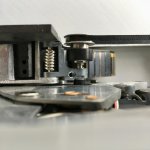eeguru
Veteran Member
I have nearly a half dozen quarter inch cartridge tapes that need dumping. The biggest challenge so far has been finding a drive with solid capstan. I have 10+ drives (mostly Wang) and they've all turned to mush. However I did find a Sun QIC drive with solid rollers last week. So I was hoping I could dump a back-stock of tapes I've collected on the shelf.
But the drives aren't the only issue. Belts and rollers in the carts themselves wear out. In the past (10+ years ago now), I've had some limited luck transplanting the hardware from a new cart to an old one in order to read it in a drive. So after I found this working QIC drive, I tried some write/read test runs of NOS tapes I had on the shelf before I used them for organ donors. I tried 1 tape from 3 different NOS batches. Between 2 and 30 second of motor activity, all the belts snapped! So it's either this particular lone working drive is being rough on tapes, or the NOS DC600A stock is starting to brittle out as bad as the old tapes.
Any suggestions on how to a) refurbish the older tape drives, b) recondition old tapes to work in either this lone working drive or a reconditioned one, or c) any service I can send my current tape stock to be dumped and archived?
Thanks
But the drives aren't the only issue. Belts and rollers in the carts themselves wear out. In the past (10+ years ago now), I've had some limited luck transplanting the hardware from a new cart to an old one in order to read it in a drive. So after I found this working QIC drive, I tried some write/read test runs of NOS tapes I had on the shelf before I used them for organ donors. I tried 1 tape from 3 different NOS batches. Between 2 and 30 second of motor activity, all the belts snapped! So it's either this particular lone working drive is being rough on tapes, or the NOS DC600A stock is starting to brittle out as bad as the old tapes.
Any suggestions on how to a) refurbish the older tape drives, b) recondition old tapes to work in either this lone working drive or a reconditioned one, or c) any service I can send my current tape stock to be dumped and archived?
Thanks



